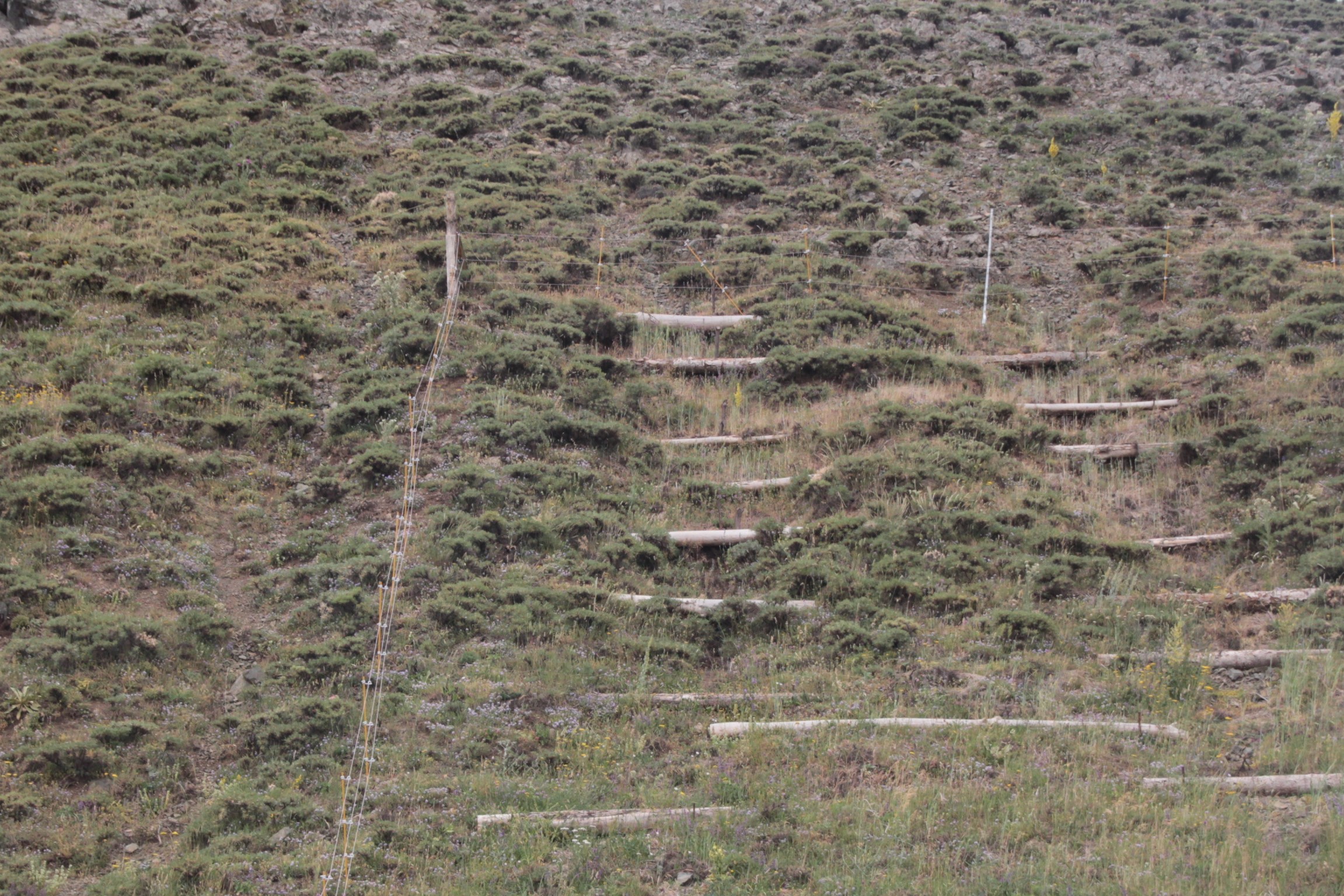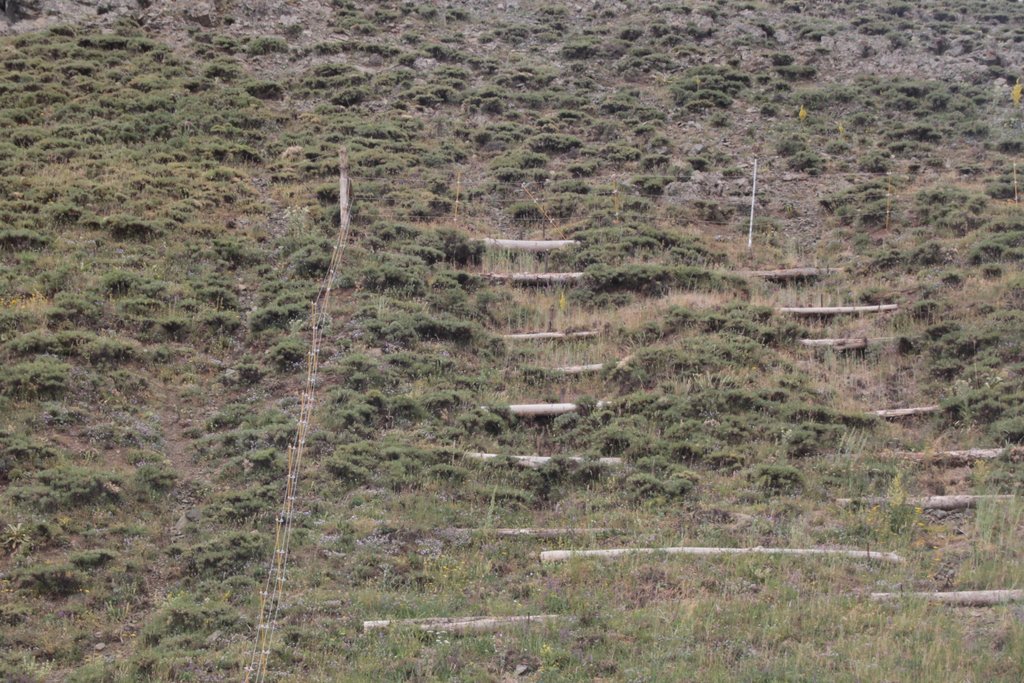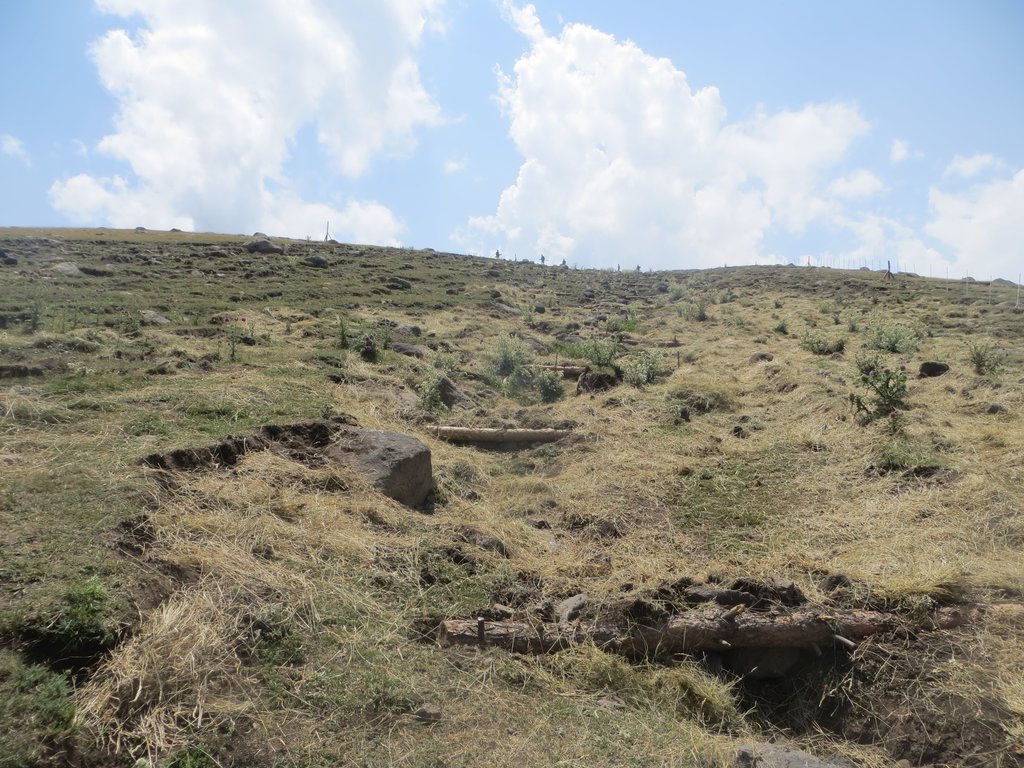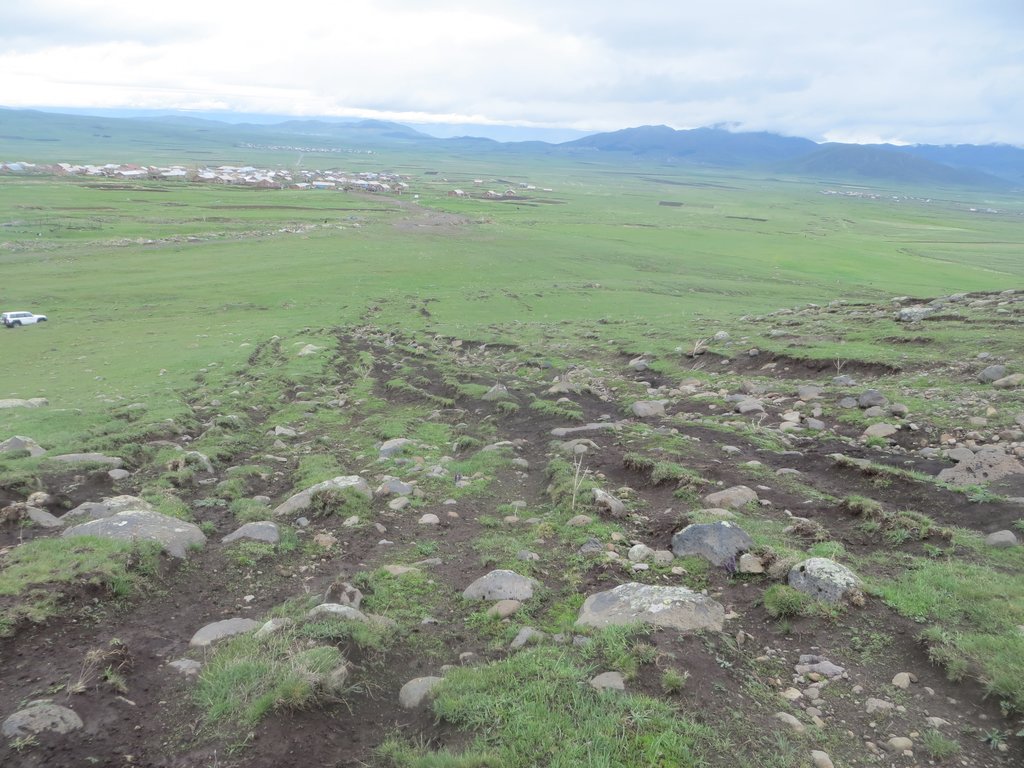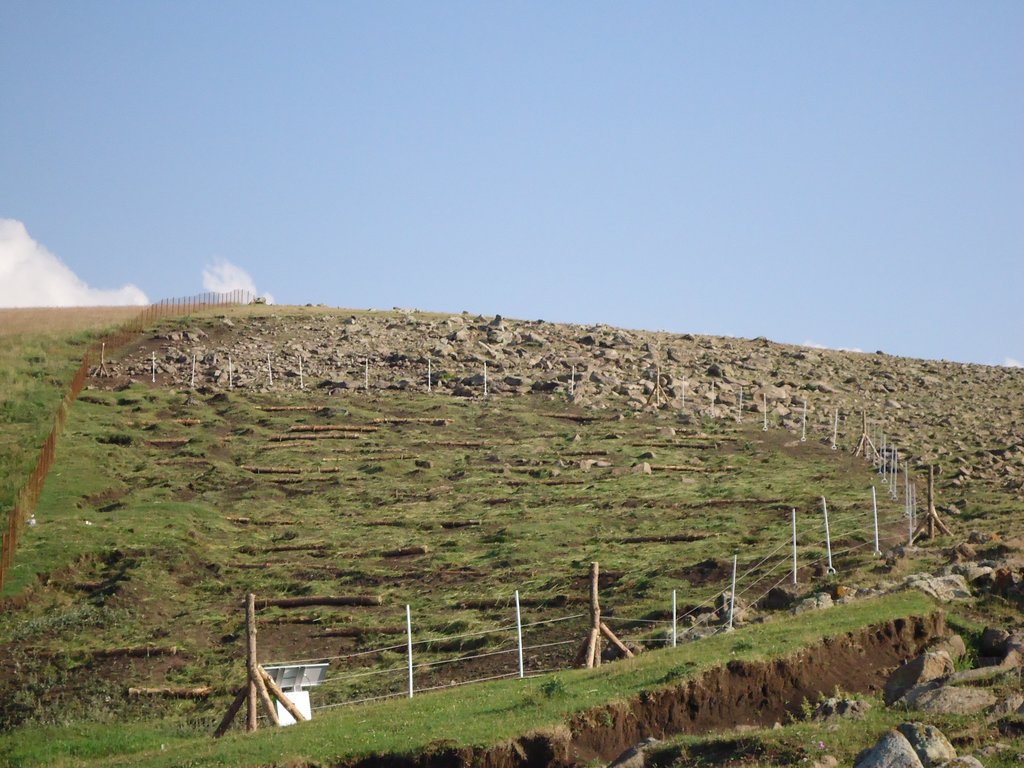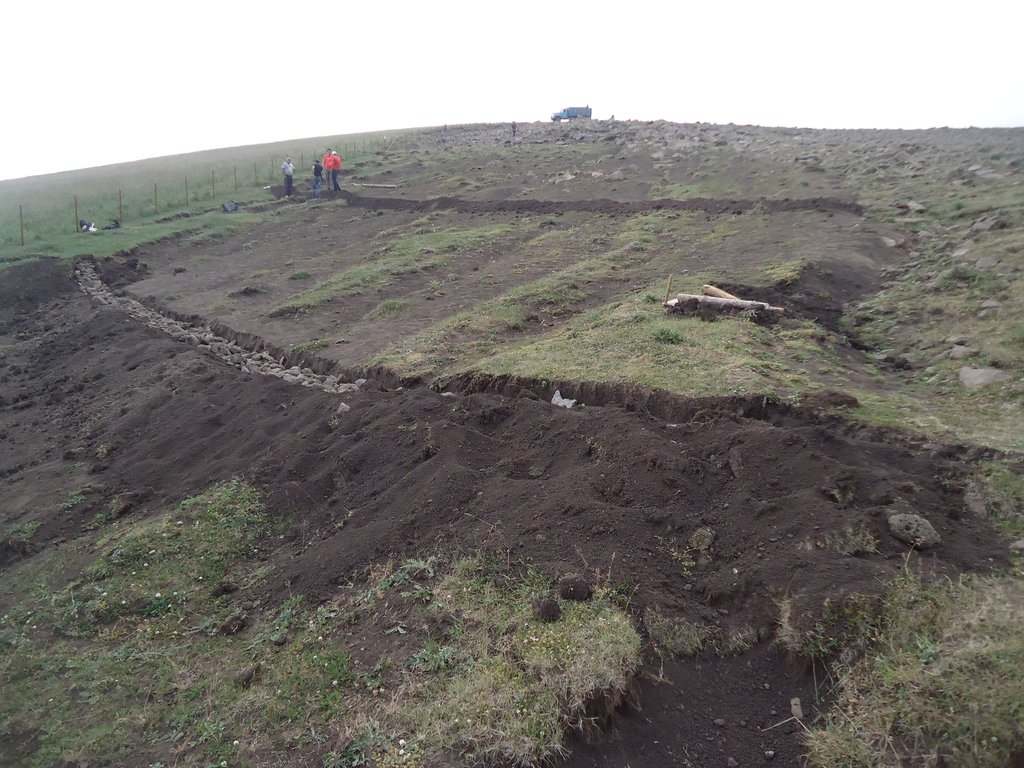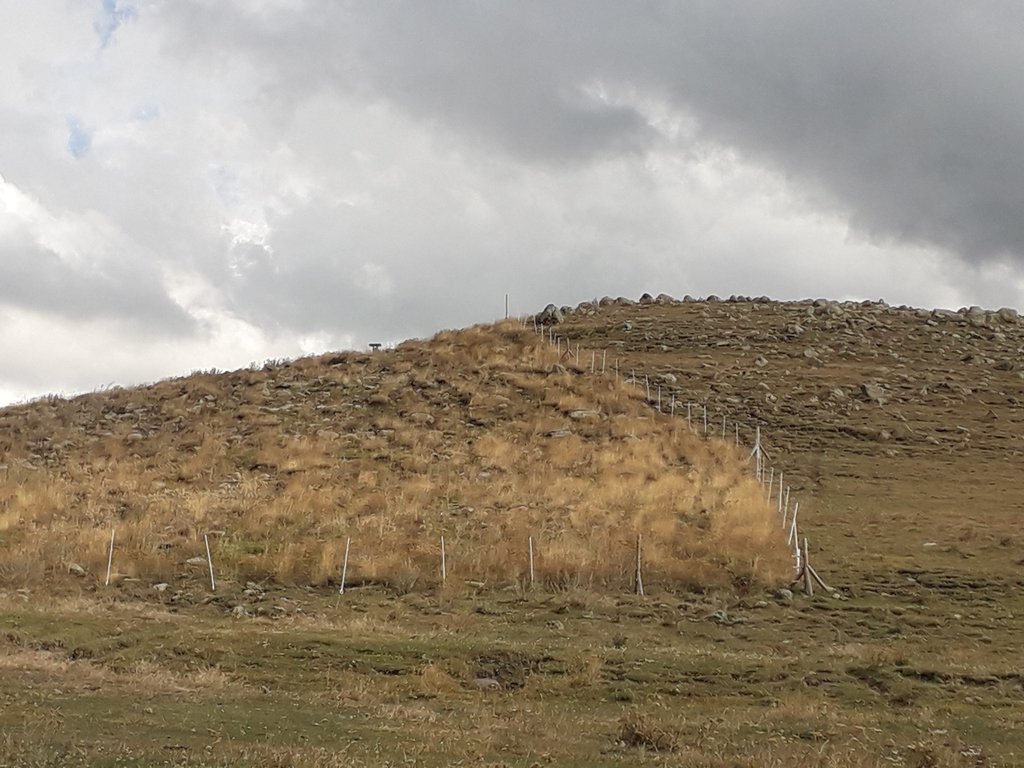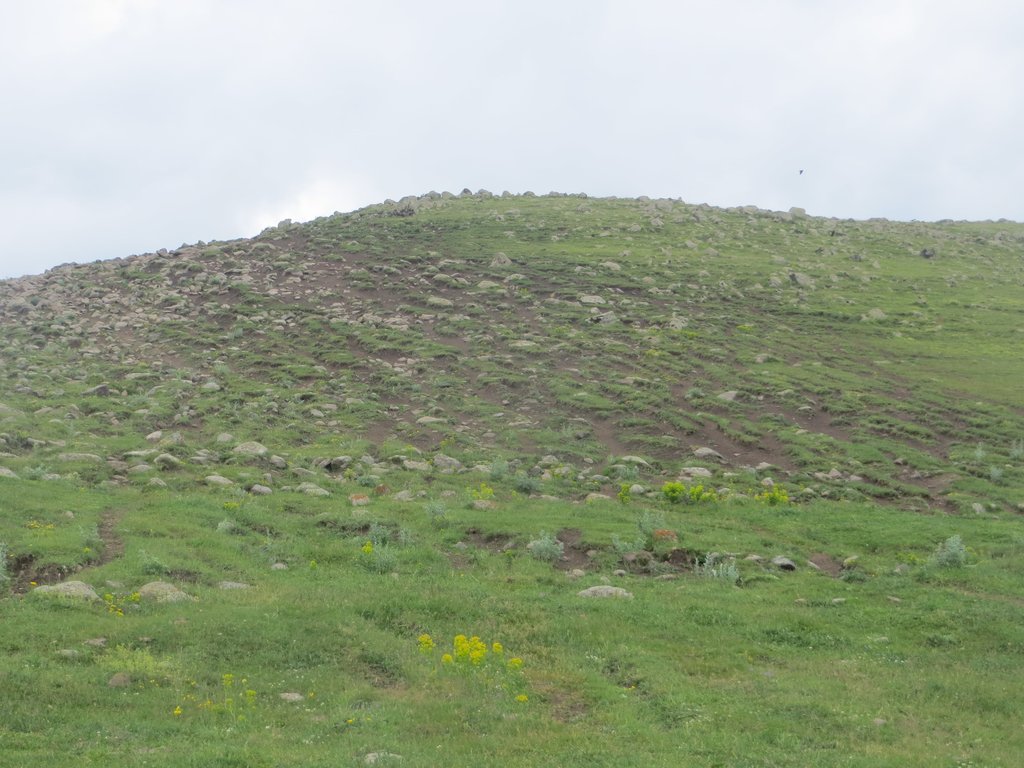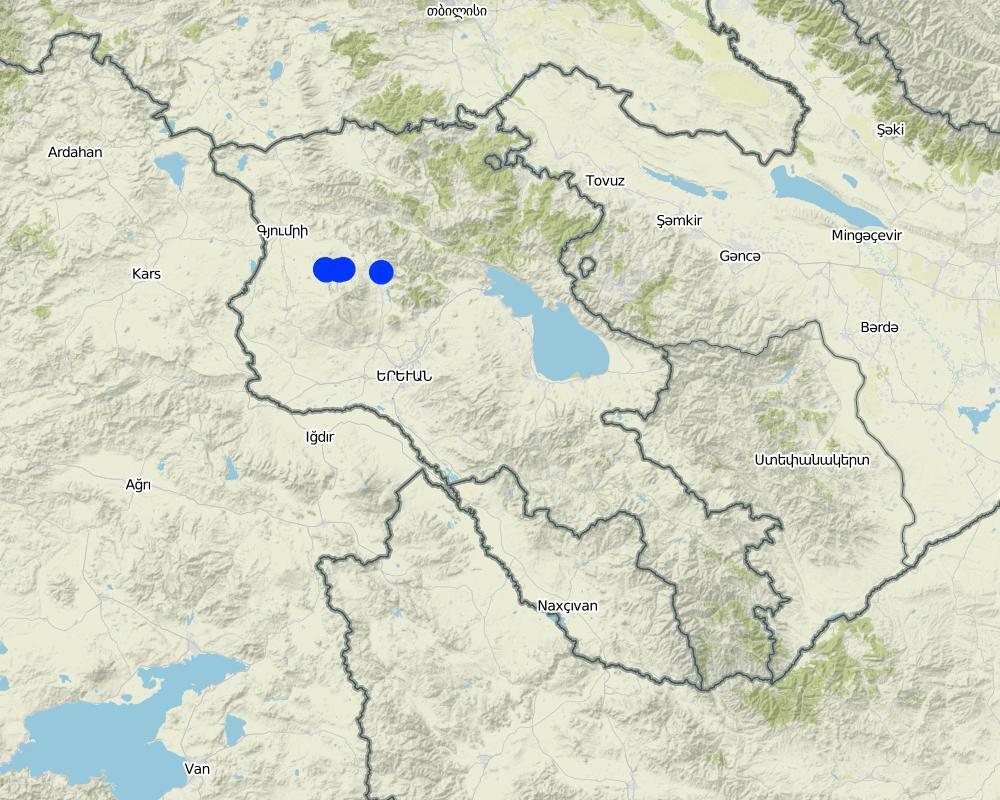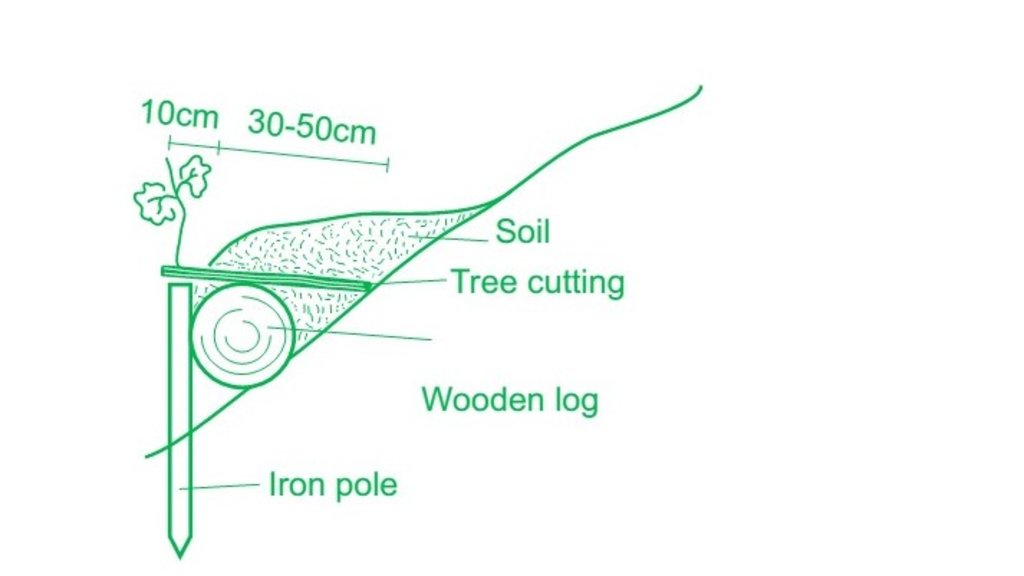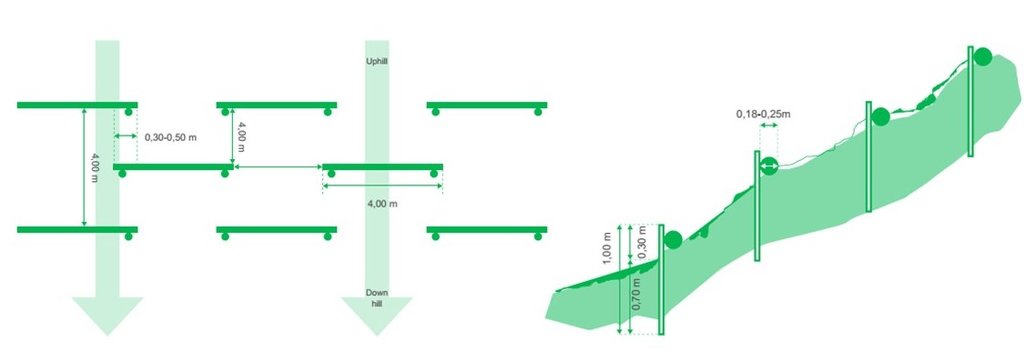Slope erosion control using wooden pile walls [Armenia]
- Creation:
- Update:
- Compiler: Hanns Kirchmeir
- Editor: Artur Hayrapetyan
- Reviewer: Ursula Gaemperli
technologies_4092 - Armenia
View sections
Expand all Collapse all1. General information
1.2 Contact details of resource persons and institutions involved in the assessment and documentation of the Technology
Key resource person(s)
SLM specialist:
Mnatsyan Aghasi
+374 (0)96001193
aghasi.mnatsyan@giz.de
GIZ
4/1 Baghramyan Street, 0019 Yerevan, Armenia
Armenia
SLM specialist:
Khachatryan Hrant
+374 94 839083 / +374 91 926092
hkhachatryan84@gmail.com
ESAC NGO, Armenian National Agrarian Univercity
Yerevan, Davit Anhaght 23
Armenia
SLM specialist:
Huber Michael
0043463504144-24
huber@e-c-o.at
E.C.O. Institute of Ecology
Lakeside B07b 9020 Klagenfurt
Austria
Name of project which facilitated the documentation/ evaluation of the Technology (if relevant)
Integrated Biodiversity Management, South Caucasus (IBiS)Name of the institution(s) which facilitated the documentation/ evaluation of the Technology (if relevant)
Deutsche Gesellschaft für Internationale Zusammenarbeit (GIZ)1.3 Conditions regarding the use of data documented through WOCAT
When were the data compiled (in the field)?
03/10/2018
The compiler and key resource person(s) accept the conditions regarding the use of data documented through WOCAT:
Ja
1.4 Declaration on sustainability of the described Technology
Is the Technology described here problematic with regard to land degradation, so that it cannot be declared a sustainable land management technology?
Nee
1.5 Reference to Questionnaire(s) on SLM Approaches
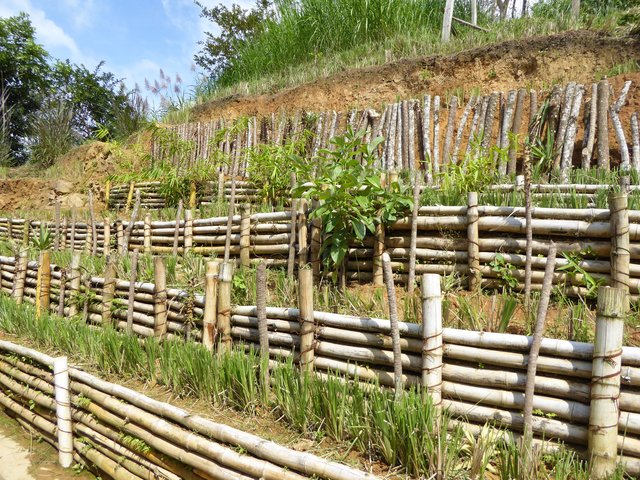
Estabilización de laderas de manera participativa [Honduras]
La bioingeniería comprende una serie de técnicas que utilizan materiales vegetativos vivos para prevenir la erosión y el deslizamiento de laderas y taludes. Las obras de bioingeniería se aplican a base de un análisis integrado de riesgo, son de multi-uso en su conjunto, tienen un bajo costo de construcción y …
- Compiler: Helen Gambon
2. Description of the SLM Technology
2.1 Short description of the Technology
Definition of the Technology:
Small horizontal wooden structures and terraces on eroded slopes built to mitigate sheet or rill erosion and slow down water run-off. The technology is easy to apply and efficient to mitigate erosion processes of the upper soil layer and to stop small rock falls.
2.2 Detailed description of the Technology
Description:
In the provinces of Aragatsotn and Shirak in Armenia, the weather is cold and temperate with dry summer. Steep slopes, pastures and some autochthonous oak forests make up the area. Farmers make most of their income with grazing by manual labour. The carrying capacity of pastures in the vicinity is regularly exceeded, and they degrade more and more. In order to stabilize the steep eroded slopes, pile walls were established. Pile walls are horizontal constructions along a slope, functioning as erosion control measures by slowing down the superficial water runoff, retaining materials and supporting the rehabilitation of vegetation.
The major advantages are: It is not expensive since mostly locally available materials can be used, and a positive effect can already be observed within a year. Also, the pile walls can be established relatively easy without any need of heavy machinery or specific knowledge and, therefore, allow the involvement of the local population.
In the case of the implementation in Armenia, the exact location for the pilot measures was selected in such a way that grazing activities were almost not impaired. For temporary exclusion of livestock, electric fencing was used. Within the fenced area, pile walls were established in the washed-out rills along the slope to address the water erosion phenomena.
The technical requirements and workload for the construction of a pile wall are relatively low. The needed resources require iron piles, a hammer, wooden logs (or a bundle of branches) and tree cuttings. First, the wooden logs were cut in 1-2 m length to fit into the irregular rills of the slope. After identifying the locations of individual pile walls, the team fixed the logs with iron poles of about 70-100cm length. The distance between the pile walls varies between 1-3m, depending on the topography: the steeper the slope, the closer the distance. The space behind the logs was filled with soil, plant material and rocks to stabilize the construction and to reduce the risk of water washing out the soil and passing below the logs. As a last step, the terraces were covered with hay to provide protection against precipitation and to accelerate re-growth of grass through the seeds contained in the hay residuals.
Community members were surprised how easy and quick the pile walls could be established. A team of two workers established a pile wall within 30 min. Since these areas are usually intensively used and thus are of high importance for the community, even a temporary exclusion from use must be thoroughly discussed and agreed upon.
The measure slows down vertical water-run off and provides steps for cattle. Due to temporary fencing and the application of hay mulch vegetation is recovering on these parts.
2.3 Photos of the Technology
2.4 Videos of the Technology
Comments, short description:
https://www.youtube.com/watch?v=Apt2D9i18a0
ESAC Project Video
Date:
27/03/2018
Location:
Argatsotn/Shirak Marz
Name of videographer:
ESAC
2.5 Country/ region/ locations where the Technology has been applied and which are covered by this assessment
Country:
Armenia
Region/ State/ Province:
Aragatsotn and Shirak Marzes (Provinces)
Further specification of location:
Lusagyugyh, Hnaberd, Ghegadhzor, Saralandj, Mets Mantash
Map
×2.6 Date of implementation
If precise year is not known, indicate approximate date:
- less than 10 years ago (recently)
2.7 Introduction of the Technology
Specify how the Technology was introduced:
- through projects/ external interventions
3. Classification of the SLM Technology
3.1 Main purpose(s) of the Technology
- improve production
- reduce, prevent, restore land degradation
- preserve/ improve biodiversity
- reduce risk of disasters
3.2 Current land use type(s) where the Technology is applied

Grazing land
Extensive grazing land:
- Semi-nomadism/ pastoralism
Main animal species and products:
cattle (and sheep)
3.3 Further information about land use
Water supply for the land on which the Technology is applied:
- mixed rainfed-irrigated
Number of growing seasons per year:
- 1
Livestock density (if relevant):
0.89-1.30 pasture load/ha
3.4 SLM group to which the Technology belongs
- pastoralism and grazing land management
- improved ground/ vegetation cover
- minimal soil disturbance
3.5 Spread of the Technology
Specify the spread of the Technology:
- evenly spread over an area
If the Technology is evenly spread over an area, indicate approximate area covered:
- < 0.1 km2 (10 ha)
3.6 SLM measures comprising the Technology

vegetative measures
- V1: Tree and shrub cover
- V2: Grasses and perennial herbaceous plants

structural measures
- S1: Terraces
3.7 Main types of land degradation addressed by the Technology

soil erosion by water
- Wt: loss of topsoil/ surface erosion
- Wg: gully erosion/ gullying
- Wm: mass movements/ landslides

soil erosion by wind
- Et: loss of topsoil

physical soil deterioration
- Pc: compaction

biological degradation
- Bc: reduction of vegetation cover
3.8 Prevention, reduction, or restoration of land degradation
Specify the goal of the Technology with regard to land degradation:
- reduce land degradation
- restore/ rehabilitate severely degraded land
4. Technical specifications, implementation activities, inputs, and costs
4.1 Technical drawing of the Technology
4.2 Technical specifications/ explanations of technical drawing
Required materials for 1 pile wall:
- 2 iron poles (0.7-1m) and a hammer
- 1 wooden log (ca. 4 m, 20-25cm diameter)
- 10-20 shrub cuttings (e.g. Salix species)
Selection of appropriate sites for pile walls (where and how to put them):
The logs are being spread on the slope as indictated in the scheme of the figure. The steeper the slope the narrower the vertical spacing in between (max. 4m, min. 1-2 m). On uneven slopes, place the along the depressions as these are the areas where water-run off is strongest. Parts which show no erosion signs can be left out to not destroy existing vegetation cover. The location of the pile walls is determined by the slope and serves to stabilize the slope at superficial level (10-30 cm). It landslides occur that involve deeper soil layers, this technology is not efficient.
Building process:
After placing the logs, those are fixed with two irons at the end (alternatively wooden posts can be used as well). After fixing the logs, the space behind needs to be filled (slight terracing of the slope). Additionally, either shrub seedlings or living cuttings from species such as willows (ca. 50cm long, 2-5cm diameter) should be integrated. Finally, the open soil should be covered by a layer of 2-5 cm of hay/grass containing seeds and eventually additional seeds (from local species) to promote the re-establishment of vegetation. This has also the benefit that this cover keep humidity in the soil, which is particularly important in (semi-)arid areas.
Species used/density:
At least 20 cuttings per pile wall should be planted. Depending on the survival rates, it can be also more. Shrubs additionally stabilize the slope and are to some extent protected by the pile wall.
4.3 General information regarding the calculation of inputs and costs
Specify how costs and inputs were calculated:
- per Technology area
Indicate size and area unit:
0.15 ha
Specify currency used for cost calculations:
- US Dollars
Indicate average wage cost of hired labour per day:
ca. 20 USD per worker and day (unskilled local workers), 120 USD per day (local expert)
4.4 Establishment activities
| Activity | Type of measure | Timing | |
|---|---|---|---|
| 1. | Selection of eroded sites and size | Management | anytime |
| 2. | Clarification of land user rights | Management | anytime |
| 3. | Calculate amount of logs and irons needed | Management | anytime |
| 4. | Materials check: Local materials and procurement of other materials | Management | anytime |
| 5. | Place logs on the eroded slope (favor depressions where water flows are) | Structural | anytime (best in spring and autumn) |
| 6. | Fix logs with two iron poles at both sides of the log | Structural | anytime (best in spring and autumn) |
| 7. | Fill the space behind the log with soil, rocks and (willow) cuttings | Structural | early spring or late autumn (willow cuttings without leaves) |
| 8. | Flatten the area behind the log (small terracing) | Structural | anytime (best in spring and autumn) |
| 9. | Use additional hay/grass mulch to cover open soil and add additional seeds | Vegetative | best in spring (alternatively in late autumn) |
| 10. | If it is grazing area: Fence the area for at least 2-3 vegetation periods | Management | during grazing period |
4.5 Costs and inputs needed for establishment
| Specify input | Unit | Quantity | Costs per Unit | Total costs per input | % of costs borne by land users | |
|---|---|---|---|---|---|---|
| Labour | Unskilled worker: Implementation of field measures | person days | 30.0 | 21.0 | 630.0 | 10.0 |
| Labour | Skilled expert (Implementation supervision and project management | person days | 14.0 | 120.0 | 1680.0 | |
| Labour | Transportation costs (truck, experts) | rental days | 12.0 | 54.0 | 648.0 | 10.0 |
| Labour | Administration costs | month | 1.0 | 127.0 | 127.0 | |
| Equipment | Consumables | set | 1.0 | 59.0 | 59.0 | 10.0 |
| Equipment | Electric tools | set | 1.0 | 424.0 | 424.0 | 10.0 |
| Equipment | P3800 Fence energizer + Box and equipment | set | 1.0 | 345.0 | 345.0 | |
| Equipment | Solar Panel for fence energizer | piece | 1.0 | 233.0 | 233.0 | |
| Equipment | Battery and fence tester | piece | 1.0 | 203.0 | 203.0 | |
| Plant material | Cuttings (20 per pile wall) (not used as it is being grazed) | pieces | ||||
| Plant material | Hay/grass for mulch cover (Bales ca.20kg) | kg | 800.0 | 0.08 | 64.0 | |
| Construction material | Wooden logs (3m, 20cm diameter) | pieces | 50.0 | 17.0 | 850.0 | |
| Construction material | Iron poles (0.7-1m, 10 mm diameter) | pieces | 150.0 | 2.1 | 315.0 | |
| Construction material | Electric Fence Polywire | m | 1300.0 | 0.3 | 390.0 | |
| Construction material | Electric Fence Corner donut insulator | pieces | 27.0 | 1.0 | 27.0 | |
| Construction material | Earth stakes | pieces | 3.0 | 22.0 | 66.0 | |
| Construction material | Electric Fence Spring Gate Set | piece | 1.0 | 42.0 | 42.0 | |
| Construction material | Wooden Posts | pieces | 9.0 | 6.4 | 57.6 | 20.0 |
| Total costs for establishment of the Technology | 6160.6 | |||||
If land user bore less than 100% of costs, indicate who covered the remaining costs:
GIZ Project
Comments:
Initial costs were comparatively high as it is a pilot project. Thus, staff costs and the procurement of electric fence equipment made costs rather high. If materials can be obtained locally costs go down as far as 23 USD/pile wall (including material and work).
4.6 Maintenance/ recurrent activities
| Activity | Type of measure | Timing/ frequency | |
|---|---|---|---|
| 1. | Regular check of fence | Structural | Once per two weeks |
| 2. | Installation and deinstallation of electric fence | Structural | Once per year |
| 3. | Changing the broken posts | Structural | once per year |
| 4. | Optional refill of stones and/or soil if washed out | Structural | twice per year |
Comments:
Almost all maintenance activity refer to the maintenance of the electric fence (which is being removed in winter) and needs to be re-established during the grazing period. The pile wall itself does not need maintenance measures.
4.7 Costs and inputs needed for maintenance/ recurrent activities (per year)
| Specify input | Unit | Quantity | Costs per Unit | Total costs per input | % of costs borne by land users | |
|---|---|---|---|---|---|---|
| Labour | Regular check of fence | workdays | 8.0 | 21.0 | 168.0 | 100.0 |
| Labour | Installation and deinstallation of electric fence | workdays | 8.0 | 21.0 | 168.0 | 100.0 |
| Labour | Changing the broken posts | workdays | 1.0 | 21.0 | 21.0 | 100.0 |
| Labour | Optional refill of stones and/or soil if washed out | workdays | 3.0 | 21.0 | 63.0 | 100.0 |
| Total costs for maintenance of the Technology | 420.0 | |||||
4.8 Most important factors affecting the costs
Describe the most determinate factors affecting the costs:
Grazing (if fencing is needed it is the most costly part)
Wooden logs (if bought). This can be turned to zero by either using local wood (if permitted) or bundles of branches of specific species (e.g. willows).
5. Natural and human environment
5.1 Climate
Annual rainfall
- < 250 mm
- 251-500 mm
- 501-750 mm
- 751-1,000 mm
- 1,001-1,500 mm
- 1,501-2,000 mm
- 2,001-3,000 mm
- 3,001-4,000 mm
- > 4,000 mm
Specify average annual rainfall (if known), in mm:
521.00
Specifications/ comments on rainfall:
In Aparan, the climate is cold and temperate. Aparan has a significant amount of rainfall during the year. This is true even for the driest month. Precipitation peaks are in May and June.
Indicate the name of the reference meteorological station considered:
Aparan, Aragatsotn Marz, Armenia
Agro-climatic zone
- semi-arid
According to Köppen and Geiger, the climate is classified as Dfb (Cold/continental, no dry season, warm summers). Annual mean temperature is 5.2. °C. The warmest month of the year is August, with an average temperature of 16.4 °C. January has the lowest average temperature of the year with -6.9 °C.
5.2 Topography
Slopes on average:
- flat (0-2%)
- gentle (3-5%)
- moderate (6-10%)
- rolling (11-15%)
- hilly (16-30%)
- steep (31-60%)
- very steep (>60%)
Landforms:
- plateau/plains
- ridges
- mountain slopes
- hill slopes
- footslopes
- valley floors
Altitudinal zone:
- 0-100 m a.s.l.
- 101-500 m a.s.l.
- 501-1,000 m a.s.l.
- 1,001-1,500 m a.s.l.
- 1,501-2,000 m a.s.l.
- 2,001-2,500 m a.s.l.
- 2,501-3,000 m a.s.l.
- 3,001-4,000 m a.s.l.
- > 4,000 m a.s.l.
Indicate if the Technology is specifically applied in:
- not relevant
Comments and further specifications on topography:
The technology is applicable on hills and steep slopes with an inclination between 10° and 30 (40)°
5.3 Soils
Soil depth on average:
- very shallow (0-20 cm)
- shallow (21-50 cm)
- moderately deep (51-80 cm)
- deep (81-120 cm)
- very deep (> 120 cm)
Soil texture (topsoil):
- medium (loamy, silty)
Soil texture (> 20 cm below surface):
- fine/ heavy (clay)
Topsoil organic matter:
- medium (1-3%)
5.4 Water availability and quality
Ground water table:
5-50 m
Availability of surface water:
medium
Water quality (untreated):
good drinking water
Is water salinity a problem?
Nee
Is flooding of the area occurring?
Ja
Regularity:
episodically
Comments and further specifications on water quality and quantity:
There are substantial amounts of water (seasonally) from water from melted snow of Aragats mountain
5.5 Biodiversity
Species diversity:
- medium
Habitat diversity:
- low
Comments and further specifications on biodiversity:
The area is widely used as pasture and shows some degradation signs (e.g. inpalatable plants spreading, open soil, decreasing number of plant species, spreading of Astragalus). On some slopes, autochtonous oak forests (Quercus macranthera) still exist. The area consists of typical sub-alpine to alpine grasslands with medium species diversity.
5.6 Characteristics of land users applying the Technology
Sedentary or nomadic:
- Sedentary
Market orientation of production system:
- mixed (subsistence/ commercial
Off-farm income:
- 10-50% of all income
Relative level of wealth:
- poor
- average
Individuals or groups:
- groups/ community
Level of mechanization:
- manual work
Gender:
- women
- men
Age of land users:
- youth
- middle-aged
Indicate other relevant characteristics of the land users:
The land owners are the communities in the target region on behalf of community mayors.
5.7 Average area of land owned or leased by land users applying the Technology
- < 0.5 ha
- 0.5-1 ha
- 1-2 ha
- 2-5 ha
- 5-15 ha
- 15-50 ha
- 50-100 ha
- 100-500 ha
- 500-1,000 ha
- 1,000-10,000 ha
- > 10,000 ha
Is this considered small-, medium- or large-scale (referring to local context)?
- small-scale
5.8 Land ownership, land use rights, and water use rights
Land ownership:
- state
- communal/ village
Land use rights:
- open access (unorganized)
- leased
Water use rights:
- open access (unorganized)
5.9 Access to services and infrastructure
health:
- poor
- moderate
- good
education:
- poor
- moderate
- good
technical assistance:
- poor
- moderate
- good
employment (e.g. off-farm):
- poor
- moderate
- good
markets:
- poor
- moderate
- good
energy:
- poor
- moderate
- good
roads and transport:
- poor
- moderate
- good
drinking water and sanitation:
- poor
- moderate
- good
financial services:
- poor
- moderate
- good
6. Impacts and concluding statements
6.1 On-site impacts the Technology has shown
Socio-economic impacts
Production
fodder quality
Comments/ specify:
The erosion control masures stopped top soil Erosion and Gully Erosion in the pasture land.
Income and costs
workload
Comments/ specify:
The workload for implementing the measures does not pay off within the first view years but is a long term investment in saving soil productivity.
Socio-cultural impacts
SLM/ land degradation knowledge
Comments/ specify:
The intervention raised awareness to soil erosion and new technologies have been trained to village stakeholders (pile walls, electric fencing)
Ecological impacts
Water cycle/ runoff
water quantity
Comments/ specify:
Water run off is decreased and soil moister is increase by better infiltration of water into the soil.
evaporation
Comments/ specify:
The increase of vegetation leads to an increase of evaporation-transpiration.
Soil
soil moisture
Comments/ specify:
Water run off is decreased by pile walls and better vegetation cover and soil moister is increase by better infiltration of water into the soil.
soil loss
Comments/ specify:
Decrease of water run off by pile walls and increased vegetation cover leads to decrease of soil loss.
soil organic matter/ below ground C
Comments/ specify:
Increase of vegetation leads to more root activity and humus increase by increase of litter.
Biodiversity: vegetation, animals
Vegetation cover
Comments/ specify:
The stop of grazing and trampling by the fence leads to fast increase of vegetation cover.
biomass/ above ground C
Comments/ specify:
The stop of grazing leads to significant increase of above ground biomass.
plant diversity
Comments/ specify:
On heavily eroded sites the measure lead to increase of plant species.
Climate and disaster risk reduction
fire risk
Comments/ specify:
The increase of above soil biomass increase the risk of grass-fire in autumn during or after the dry season.
6.2 Off-site impacts the Technology has shown
buffering/ filtering capacity
Comments/ specify:
through increased vegetation cover and reduced speed of superficial water-runoff and increase of water capacity of the slope above the village.
wind transported sediments
Comments/ specify:
partially improved through increased vegetation cover and less open soil
6.3 Exposure and sensitivity of the Technology to gradual climate change and climate-related extremes/ disasters (as perceived by land users)
Gradual climate change
Gradual climate change
| Season | Type of climatic change/ extreme | How does the Technology cope with it? | |
|---|---|---|---|
| annual temperature | increase | not well | |
| seasonal temperature | winter | increase | not well |
| seasonal temperature | summer | increase | not well |
| annual rainfall | decrease | ||
| seasonal rainfall | spring | increase | not well |
| seasonal rainfall | autumn | increase | not well |
| seasonal rainfall | winter | decrease | not well |
| seasonal rainfall | summer | decrease | not well |
Climate-related extremes (disasters)
Climatological disasters
| How does the Technology cope with it? | |
|---|---|
| drought | not well |
| land fire | not well |
Comments:
Seasonal raifall is different, but the annual rainfall has decreased. The impact of technology is minor, since the area is very small.
6.4 Cost-benefit analysis
How do the benefits compare with the establishment costs (from land users’ perspective)?
Short-term returns:
negative
Long-term returns:
neutral/ balanced
How do the benefits compare with the maintenance/ recurrent costs (from land users' perspective)?
Short-term returns:
negative
Long-term returns:
slightly positive
Comments:
On the short term there is a significant increase of work load and needed resources to establish the pile walls and fencing the site. Recovery of vegetation, increase of soil carbon content and increase of productivity will need 2-5 years to be effective and give increase fodder yields of the site.
6.5 Adoption of the Technology
- single cases/ experimental
If available, quantify (no. of households and/ or area covered):
There are interested households who want to adopt the technology, but indeed there is nobody who implemeted the technology by himself/herself.
Of all those who have adopted the Technology, how many have did so spontaneously, i.e. without receiving any material incentives/ payments?
- 0-10%
6.6 Adaptation
Has the Technology been modified recently to adapt to changing conditions?
Ja
Specify adaptation of the Technology (design, material/ species, etc.):
Due to unavailablity of local seeds, local hay/grass was used to provide mulching cover and add locally adapted seeds
On one site an additional drainage trench was prepared as the soil was very compacted and vegetation cover was completely destroyed. The trench was filled with rocks which are available in abundance.
6.7 Strengths/ advantages/ opportunities of the Technology
| Strengths/ advantages/ opportunities in the land user’s view |
|---|
| Improvement of road of animals, improvement of quality of pasture and vegetation cover, overcome of erosion, regulation of water flow, better view of the area, dissemination of seeds to other areas |
| Strengths/ advantages/ opportunities in the compiler’s or other key resource person’s view |
|---|
| Technology is easy to apply and works mostly with local materials and requires no specific knowledge. Materials can be adapted (e.g. if timber is scarce, bundles of willow branches can be used as alternative) |
| Technology is able to stabilize superficial erosion processes and support recovery of vegetation on steep slopes. It can also stop small rock falls. |
| Technology can also be adapted to fortify/stabilize paths and cattle paths on slopes (e.g. when a walking path is crossing a small gully section). Thus, it can also stop erosion processes caused by trampling or hikers |
6.8 Weaknesses/ disadvantages/ risks of the Technology and ways of overcoming them
| Weaknesses/ disadvantages/ risks in the land user’s view | How can they be overcome? |
|---|---|
| Limited availability of material such as electric fence, solar panels, etc in the local market | At the moment they can be imported |
| relatively high cost for material | Using cheap and local material |
| Limitation of cattle road | Use other alternative road for animals |
| Weaknesses/ disadvantages/ risks in the compiler’s or other key resource person’s view | How can they be overcome? |
|---|---|
| If not installed properly, water flows on the sides of the pile walls and below and the barrier becomes ineffective |
Take care during construction that the space below the logs is filled appropriately. Take care of appropriate re-establishment of a vegetation cover |
| If area is being grazed, it is challenging to re-establish vegetation. Cuttings which further stabilize the slope are unlikely to succeed. |
Temporary fencing of the area or permanent fencing and use of area for hay making |
7. References and links
7.1 Methods/ sources of information
- field visits, field surveys
3-5 informants
- interviews with land users
- interviews with SLM specialists/ experts
- compilation from reports and other existing documentation
7.2 References to available publications
Title, author, year, ISBN:
Handbook on Integrated Erosion Control A Practical Guide for Planning and Implementing Integrated Erosion Control Measures in Armenia, GIZ (ed.), 2018, ISBN 978-9939-1-0722-6
Available from where? Costs?
GIZ Armenia
7.3 Links to relevant information which is available online
Title/ description:
Project website of the GIZ program
URL:
http://biodivers-southcaucasus.org/
Links and modules
Expand all Collapse allLinks

Estabilización de laderas de manera participativa [Honduras]
La bioingeniería comprende una serie de técnicas que utilizan materiales vegetativos vivos para prevenir la erosión y el deslizamiento de laderas y taludes. Las obras de bioingeniería se aplican a base de un análisis integrado de riesgo, son de multi-uso en su conjunto, tienen un bajo costo de construcción y …
- Compiler: Helen Gambon
Modules
No modules


